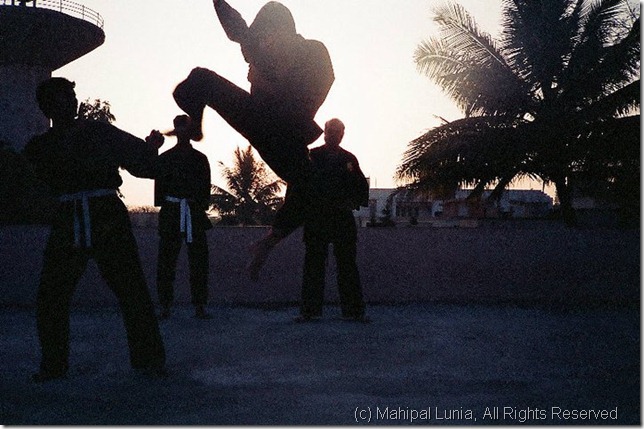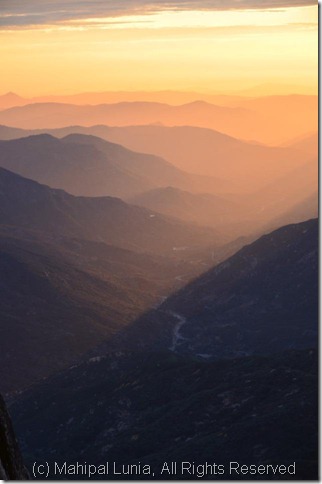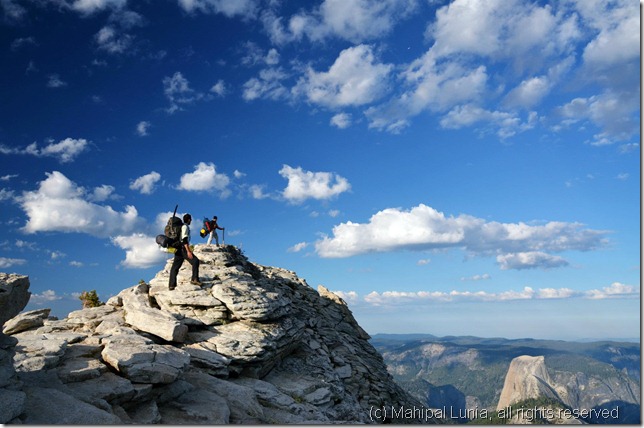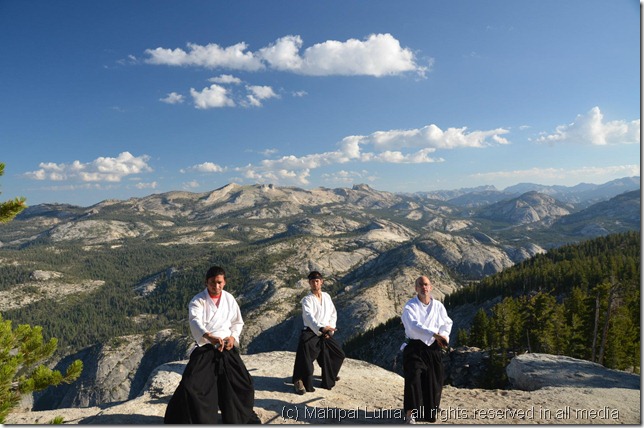The Poetics[i] of A Martial Education
His knife sneakily came in from behind the shield hand, and made its way to my neck. Instinctively, I rolled into the #6 taisabaki[ii], “adhering to the weapon hand” while moving the body to be “where the knife is not” and applied a lock on his arm. We both laughed as he then executed a rather elegant internal “turning palm change” and was out of the kansentsu waza, and thrust the knife with the other hand towards my belly. I slammed this knife hand while dropping my body weight to the ground: the “marriage to gravity[iii]” saved the day again.
We continued this for the next 45 minutes. Think of this as counter for counter[iv] and sticky weapons[v] put together. He brings 25 odd years of training in Kuntao[vi] and Silat[vii] where I usually rely on my training in KAR Aikijujutsu. We ended our session as always with some green tea or chai/Indian Tea and discussions.
Whenever our schedules permit, my friend, a very high ranking member in another school, and I enjoy comparing our concepts and techniques as well as figuring out solutions to the challenges posed by each other’s systems. We do this with the hope of discovering what works and what are the problem areas to work on. Over our chais he asked, “where did you learn those counters, I have never seen anyone do those things in my 25 years in martial arts!”
“From many places, however I predominantly credit my learning in KAR under Sastri Sensei and Vilaire Sensei for most of what you see me do plus some very personal expressions. And it was the time with Sastri Sensei in particular that opened my mind to what is possible and what one can accomplish. He put the art in the martial for me and he has always been more than a martial arts trainer to me- he is a Sensei in the truest sense of the word.”
“It’s rare to find a true teacher of art. Tell me more, what was it like learning from Sastri Sensei?”
It’s a question I get often, and can’t answer often enough. Today I decided to try and unravel that question. “I don’t know where to start, it has always been intense. We trained 5-6 days a week in the heyday, and the learning went on for 90 minutes on the mat and equally long off the mat.”
We laughed as my friend added, “Same with my Master, these guys love to teach and talk, don’t they?”
I sipped the delicious ginger chai. “I think you and I are guilty of that now, yes, we do love to discuss and philosophize about the arts. Anyways training on the basics was constant, and we did many variations/henka to the same technique. Sensei would never do the same technique twice in a row. Initially it was overwhelming, until the pattern began to reveal itself, to emerge…and that pattern was natural principles. The variations and escapes always blew me away and it was much later in the training that I realized that Sastri Sensei would slip in Menkyo, or as you would call Master, level techniques/concepts into our learning regularly. This only became obvious to me when the formal training in Menkyo began many years later, and many of the moves/counters were already self-evident.”
He was listening intently, fascinated with both KAR and my time with Sastri Sensei in particular. He too has trained in “the old ways” under a very well-known tough master. Since his graduation he has been exploring his own expression in the art. He continued, “but that can’t be it, it’s not just showing you advanced techniques early… what are you holding back?”
“Not holding back, I just don’t know how to frame it yet. The physical aspect is the easy part. If one sticks to it, most can at least imitate the moves and do it reasonably well. Sensei called that mode of learning Monkey See, Monkey Do.” We both laughed and continued sipping the tea. “However his greatest gift was opening the minds of those students who paid attention. To me, being with him was always about being cracked open to Wonder, Magick and Possibility. “
“Now we are getting somewhere Mahi, tell me about the opening of the mind. And how are you using the term mind – the somewhat limited western way or the more encompassing eastern way?” He put his cup down, clasped his hands together and leaned in to listen with a sense of fierce curiosity.
I pondered a little, as sometimes English is a hard language for me to explain the more “subtle felt aspects” of the arts. “I think of those two minds as a continuum. Let me explain. Sastri Sensei introduced all of his students to NLP in the early 1990s. Not all followed, a few did while I completely embraced it, as evident even today. The brain based pursuit of elite performance was an eye opener. For the first time, I started making the transition from pure brawn, to thinking about things…even though it was at that time in pursuit of even more brawn.” We both laughed knowingly.
He jumped in, “You think about things? Surely you are mistaken.”
We continued laughing hard, and everyone in the café turned to look at two sweaty guys with sticks and knives on their sides, talking about weird things. I continued, “So I devoured the whole NLP thing, especially the modeling aspects of it, as I wanted to move like my Sensei did. And I would take diligent notes from his lessons and build mental models to test. This was the opening of the small mind – the brain, or the western mind as you say. However the real lessons were always about how we become better human beings. He demonstrated the path, with integrity and character. He is one of the most moral/ethical men I have the privilege of knowing. When he said something, I knew he meant every word of it. And his love for the art, for his students and for his friends was unbounded. Neither money nor fame got in the way his martial arts.”
We almost had finished our chai, and ordered round two. I confessed, “you know, I f****d up quite a bit. In hindsight, my immature behavior back in the early days made enemies both in the dojo and outside. At one point I almost quit, primarily because of my ego. However, I owned up to my faults and apologized to him in person. He was compassionate and he warmly forgave and forgot everything. I must add, that I know there were times when he was angry at my behavior but he never once stopped teaching or leading by example. This was the beginning of the opening to the bigger mind, the way we Easterners think about it.”
The next cup of chai was here, and the sweet smell of Darjeeling tea and ginger just warmed up the environment even more. My friend continued, “Yes, the bigger mind is all encompassing, and the heart is the way. Western Science is just waking up to the wisdom of the heart – especially how it has its own grey matter if you will, and a decision center. You are familiar with the work of HeartMath[viii] of course. But, continue, I am curious about the training.”
As the sweet gingerly taste and rich conversation woke me up even more I continued, “yes that’s the bigger mind, opening of the heart. And what has to be learned is the courage to follow its impulses. I think that’s what most of the true meat is, it’s the place where training gives way to an education. Come one, if you are training for 20 odd years, it’s NOT to deal with a punch, lock, knife stab or a simple squabble. To walk on one’s path, to listen to one’s heart, and follow those impulses, (many of which may seem irrational) require courage. That ultimately is the training I believe he imparted on the handful who stuck through it.”
“ He laid the path from defending the physical self, to defending one’s mind to defending ones expression. I know you, like me, see the oneness of the universe. And that journey is one we go on ALONE. However the right teachers prepare you for it. Discipline the body, teach the mind to discern and invoke courage to follow one’s heart and passions. That in my opinion encapsulates my education under Sastri Sensei. From there you do have to walk alone. Martial Arts is the metaphor, if you will, that we used and still do. It’s our love. It’s our language. It’s our expression. But the target is elsewhere… it’s not just in the fighting.”
With that I felt done, complete. I had never quite articulated the training quite like this.
We finished our tea, and he paid. We started walking out to our cars, and figuring out our next play date. He continued, “Your language was interesting. While most talk about learning techniques and esoteric secrets that only they have, you seem to focus on a different plane.”
“Yes. I think good teachers educate you, teach you how to draw from within. They teach you to learn for & from yourself. And that is what he taught me how to do. He used to always tell us – do not be my vomit. Find out for yourself, show me your creativity. In the two decades I have been with him, he never tested two students the same way….. I believe any art in existence today, especially the classical systems we study were once a hypothesis that was tested and adopted. However people made deities out of the founders, and forgot the message. Don’t get me started on that thread.”
We both laughed. “So the training with Sensei was learning how to learn, and becoming who you are. And martial arts, was how we explored this. I see effective fighting as one of the benefits, not THE benefit of the learning from him. I continue to learn from him to this day, when we speak every week. We may not discuss MA techniques directly every time, but that’s the thread that informs, instructs and binds us together.”
He nodded, and I knew he understood. He continued, “I want to meet him some day and lets swap notes on specific methods of training next time.” I agreed and promised him that next time Sastri Sensei is in the Bay Area, he would. I had hoped to do justice to the training and methods, though capturing 2 decades of learning over 2 cups of chai is impossible.
“You know dude, we are both f****d. Our schools will never be enrolled to the hilt, and most likely we will die unknown in the arts we love.” I wanted to end on a funny, humbling note. We laughed hard at the irony of the whole situation.
Being a fellow philosopher and poet he said “Have you heard of Liu Yuxi[ix] famous epitaph - Inscription for a Humble home?” I know him well enough to know there had to be a point, and this was not a random tangent.
“Nope”
He stood tall, mockingly imitated an opera performer and began his preparation. I knew the poem meant a lot if he was ready to recite this “by heart.” I stopped everything to pay complete attention to him for I knew there was going to be a deep point here.
Ever so softly, as though he was sharing a big secret he recited:
“A mountain is famous not for its height, but for its immortals.
A lake is magical not because of its depth, but because of its dragons.
This house may be humble, but it is fragrant with my virtue.
The steps are covered with green moss; the window screens reflect the verdant grass.
I laugh and chat with learned gentlemen; there are no illiterates among my visitors.
I can play the harp and read the Vajra Sutra[x].
There is no noise of string and wind instruments to disturb my ears, nor any documents to tire me out.
Zhu Geliang[xi] lived in a thatched hut in Nanyang;
Yang Ziyun dwelt in a tiny shack in western Shu.
Confucius said, "How can that be considered humble?"
There was a deep silence for a minute. We nodded, hugged warmly and said our good byes. On my drive home the lines played in my mind, and I was going to soak myself in them. Poetry is the language of the mystical, and the more time you spend with it, the more it unravels. Much like the training with my Sensei, the more I go back to the lessons, the more they unravel.
That was the essence of the training with Sensei, sheer poetry. Poetry that took hold opened the mind and heart. Good poetry has layers, and layers. As the reader matures, the meaning of the poem transforms. The lines sound the same, but are felt and experienced very differently. In the Martial Arts, the moves look the same, but feel and change one completely. Hence I call it the Poetics of A Martial Education – it is about how physical, mental and emotional education came together and was aimed to produce a higher ideal than just being an effective fighter. The language he used was martial arts, music, physics and ethics coming together to weave the fabric.
I hope to be able to impact those few students who come to my little dojo, in a similar way that my Sensei did in his. Damo Arigato Sensei!
[i] Poetics is distinguished from hermeneutics by its focus not on the meaning of a text, but rather its understanding of how a text's different elements come together and produce certain effects on the subject
[ii] Tai sabaki (体捌き?) is a term from Japanese martial arts and which relates to 'whole body movement', or repositioning. It can be translated as body-management. It is a term used widely in kendo, jujutsu, aikido, judo, karate and ninjutsu. Tai sabaki is usually used to avoid an attack, such that the receiver of the attack ends up in an advantageous position and it is often wrongly referred to as evasion. The key distintion here, esp from a KAR perspective is moving from one circle to the next without interrupting the flow of energy
[iii] Marriage to Gravity – The principle of Structural integration of moving body as one, while employing the advantage of gravity in all techniques. This is something that is deeply explored in Rolfing and related somatic disciplines, and certain schools of Kenpo. From a KAR perspective I have found a direct correlation of this is essential for executing good aiki, esp for the minimal use of force and multiple strikes. In essense this is Tai Ichi – Body as one and managing ones’ relationship to gravity
[iv] Counter for counter – it’s a drill where one person feeds a technique, and the other does this defense, with the aim of brining the person down. As he ends his technique, the other begins his defense against it. And this goes on and on. We use it specifically against different systems to help our own understanding of the system we train in.
[vii] Silat (Minangkabau: silek) is a collective word for indigenous martial arts from a geo-cultural area of Southeast Asia encompassing most of the Nusantara, the Malay Archipelago and the entirety of the Malay Peninsula. Originally developed in what are now Indonesia, peninsular Malaysia, south Thailand, and Singapore, it is also traditionally practiced in Brunei, Vietnam and the southern Philippines. There are hundreds of different styles but they tend to focus either on strikes, joint manipulation, throws, bladed weaponry, or some combination thereof
[x] The Vajra Cutter Sutra (also known as the Diamond Cutter Sutra or Diamond Sutra) is one of most well-known sutras of Mahayana Buddhism. The Vajra Cutter Sutra is a discourse on the Buddhist concept of emptiness or “Wisdom Gone Beyond.”









 The cold breeze in November at 4 am does more than wake you up, as I ride a few kilometers to pick a friend up for our early morning Kenpo classes. This was a daily routine, been going on for over two years to train with a rather eccentric and rather combat oriented
The cold breeze in November at 4 am does more than wake you up, as I ride a few kilometers to pick a friend up for our early morning Kenpo classes. This was a daily routine, been going on for over two years to train with a rather eccentric and rather combat oriented 


